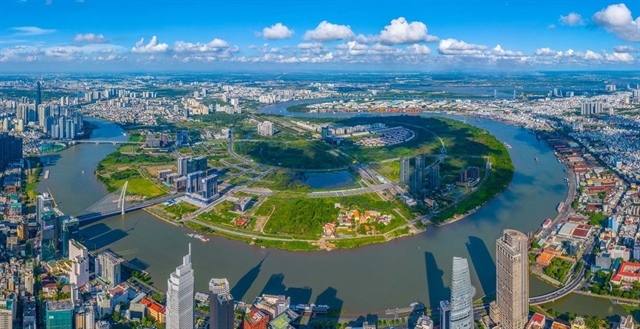FTAs to open up markets for Vietnam
FTAs to open up markets for Vietnam
Vietnam is making great strides to increase international integration for trade expansion and investment attraction. Nguyen Minh Cuong, principal economist at the Asian Development Bank in Vietnam, provides in-depth insight on the prospects of the country’s economy in the context of the Fourth Industrial Revolution and new-generation free trade agreements such as the EU-Vietnam Free Trade Agreement and the Comprehensive and Progressive Agreement for Trans-Pacific Partnership.
The early stages of the Fourth Industrial Revolution are now taking place and it will at the same time bring immense opportunities as well as formidable challenges to Vietnam. Over the past two years, there have been various discussions on the impact to the economy and how the country can be prepared to catch up and reap the benefits.
Industry 4.0 by nature is aspirational and it reflects the advanced stage of Vietnam’s transformation. It does not happen on purpose at the beginning. Rather, it evolved naturally from the digital era in the early 2000s and expanding to include Artificial Intelligence, the Internet of Things (IoT), 3D printing, Big Data, and cloud computing, with more technical innovations to come in the future.
This revolution is penetrating Vietnam incrementally and may fundamentally transform the economy. The country is enduring far-reaching economic restructuring, from labour and natural resources-driven growth to a technology and knowledge economy.
If fully maximised, these changes could help Vietnam acquire and apply the finest state-of-the art technology to promote economic growth and speed up the transition process to the knowledge economy. Industry and agriculture will have greater opportunities to improve productivity.
Efficiency gains can also be strengthened in services. The cost of trade, logistics, and transportation will fall leading to market expansion. Traditional comparative advantages would still play favourably to Vietnam at the early stage to capture the benefits, such as the demographic advantage of having more than 50 per cent of the population in working age, though this advantage will diminish rapidly in the years to come. Internet infrastructure is reasonably developed, and the country is ranked 13th among the top 20 countries for Internet usage. There are approximately 65 million Internet users in Vietnam, around 67 per cent of the population.
Challenges are, however, daunting. While some major IT corporations are fully aware of the imperatives to be prepared for Industry 4.0, by contrast, the level of engagement from most small- and medium-d enterprises (SMEs) within Vietnam on this issue is almost insignificant.
A recent survey of 2,000 SMEs in Hanoi shows that 79 per cent are not prepared to embrace Industry 4.0. Of which, 67 per cent say it is not quite relevant to their businesses, 56 per cent are confident that they would not be affected much, and interestingly 54 per cent say it is not necessary to even pay attention to Industry 4.0.
To make it more challenging for SMEs to capture Industry 4.0 benefits, technology transfer is becoming more difficult and costlier due to stricter technological copyright and partnership. This makes it even harder for SMEs to absorb new technologies.
The labour force of Vietnam would bear the most impact if this revolution comes full force. More than 80 per cent has not received proper vocational and technical training. Skilled labour is in serious shortage.
This ongoing evolution will very soon make the abundant and low-wage labour of Vietnam the thing of the past. The sectors that may face the biggest risks are labour intensive sectors with low value addition such as agriculture, forestry, fishing, textiles and garments, and assembly.
Services sectors such as retail and wholesale, entertainment, health, and education may also be at risk due to inadequate infrastructure and shortage of skilled workers. What may happen could be a widening income disparity between skilled and unskilled workers, contributing to growing unemployment and social inequality.
Within the above context, if Vietnam is to embrace Industry 4.0 to promote economic growth and help the country breakthrough the middle-income trap, the country would need to create enabling policies and a well-defined roadmap for development of Industry 4.0; accelerate the development of ICT infrastructure; make resource allocation for research and development (R&D) and innovation compulsory; put utmost priority for building centres of excellence for technological innovation and application; top up greater resources for vocational and technical training for skills development of SMEs; redouble efforts to remove barriers to doing business; and deepen Vietnam’s integration in global and regional value chains through multilateral and bilateral free trade agreements (FTAs) to facilitate technological and know-how transfer.
New-generation of FTAs in the context of 4.0
Industry 4.0 is occurring at a time when the global economy is experiencing unprecedented trade liberalisation where multilateral trade rules are at risk due to increasing protectionism.
Conflicting trends in global trade are complicating and disrupting trade and investment flows. Adding into the complexity, tightening global financial conditions may also alter capital flows. All of these trends may not only dampen economic growth, but also may exert negative impacts on technological transfer from developed to developing countries as global and regional value chains are disrupted.
In spite of temporary setbacks to the trading system, there have been encouraging and concerted efforts by developed and developing countries to sustain the rules-based trading system.
New generation of FTAs such as the Comprehensive and Progressive Agreement for Trans-Pacific Partnership (CPTPP) and the EU-Vietnam Free Trade Agreement (EVFTA) not only help uphold principles and values of existing multilateral trading system, but they also facilitate the expansion of global trade rules to higher enforcement standards.
Under these FTAs, market access is guaranteed by strong political commitments and associated with sustained economic reform. All of these create an enabling environment for the infusion of Industry 4.0 from developed to developing economies through a global and regional network of productions and value chains.
Vietnam is very active in forging a fair multilateral trading system. The country is participating actively in the World Trade Organization (WTO), the Asia-Pacific Economic Cooperation (APEC), the ASEAN, and recently ratifying the CPTPP.
Vietnam would gain substantially through improved market access for its manufacturing, textile and garments, agriculture, forestry, and fishery products. Penetration of foreign service providers into Vietnam in various services would also help transfer required skill sets and technical know-how to the services sector.
Historically, FTAs take effect in Vietnam in several stages. The ASEAN Free Trade Agreement (AFTA) was the first that Vietnam joined, in 1998. Vietnam’s participation marked a historical stage of the country’s opening up and in trade liberalisation. The second stage started with the US and Vietnam bilateral trade agreement in 2001 which was one of the most comprehensive bilateral trade pacts between the US and a developing country.
Among others, this advanced bilateral US-Vietnam trade pact paved the way for Vietnam to advance into a more challenging stage of trade openness by joining the WTO in 2007. The participation of Vietnam in these FTAs, and the country’s WTO accession have radically transformed Vietnam from a closed and command economy into one of the most open economies in terms of trade. Vietnam achieved historically high records of foreign direct investment (FDI). Export also grew rapidly.
However, despite being classed as very liberal and open, the Vietnamese economy was not genuinely integrated. The next stage comes with Vietnam’s recent ratification of the CPTPP. The new generation of FTAs enables not only market access, but also ensures that Vietnam will be part of global and regional value chains through which the country could benefit from technological transfer, and skills enhancement which are prerequisites to fully capture the benefits of Industry 4.0.
However, the flip side of the new generation of deals is that it is happening in a time when industrial evolution may radically change the structure of the global economy. Robotics would make it possible for developed markets to produce domestically more cheaply.
Flow of skilled labour, capital and technology from developed to developing countries could reverse if Industry 4.0 could knock down production costs in developed countries, which would eventually result in reconfiguration of global and regional production network and value chains. If this happens, market access for Vietnam to developed countries may become less significant.
Within this context and in addition to what is being suggested for Vietnam to embrace Industry 4.0, it is imperative for the country to speed up the economic transformation to improve economic resilience so that Vietnam is able to adjust if radical changes may happen. This transformation has to happen across sectors and within each of the sectors.
Vietnam must undergo several things. It must develop urban infrastructure to cope with rural-urban migration; build a fully-functioning multimodal transport system with railways, expressways, airports, and seaports; develop an effective logistics system that can enable efficient and quick mobility of labour, services and reducing costs to the economy; reform the labour, financial, land, and technological markets to unleash potential for economic growth; and last but not least, address the impacts of climate change.
The country’s economic development has achieved encouraging results and economic growth is sustained and broad-based. Having the advantage of being a newcomer to Industry 4.0, Vietnam can shortcut the economic transformation by putting in place appropriate policies to encourage R&D, innovation, and nurture development of SMEs and the private sector.
The new generation of FTAs are opportune for Vietnam because they provide greater market access and more opportunities for greater integration in both global and regional value chains.
However, Vietnam would have to accelerate economic integration before any major changes can reverse the flow of trade, investment and services. Otherwise, the country will be left behind and remain in the middle-income trap.
























